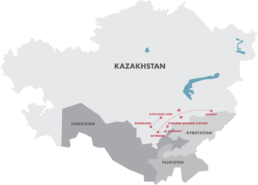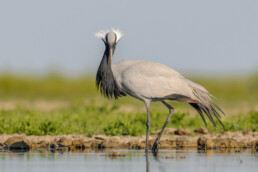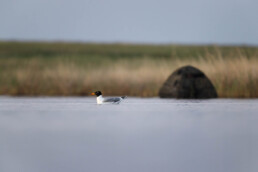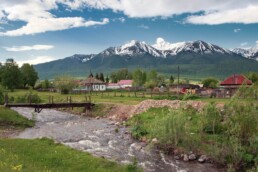HISTORIC.
PRISTINE.
UNKNOWN.
Kazakhstan is located just due east to Europe, near famous migration hotspots like Batumi in the Republic of Georgia. For a long time, Kazakhstan has been known for its large variety of rare Western Palearctic species making it an exciting place to go birding for anyone interested in Siberian and Central Asian vagrants.
The best time to visit is during fall migration, and on this venture, we head for southern Kazakhstan – a migration hotspot. The movements of birds are among their most captivating traits. We will spend most of our time in the vicinity of the Chokpak Ringing Station and the oldest national park of the former USSR – Aksu-Dzhabagly Nature Reserve.
In addition to this, we will also explore the Kyzyl-Kum desert for some unique resident birds and more wonderful migratory species.

TOUR HIGHLIGHTS
Four core moments you'll never forget
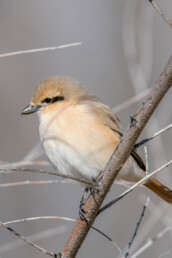
Enjoy the morning birding in the garden of our hotel, a beautiful green oasis, an attraction for Asian Paradise-Flycatchers, and more!
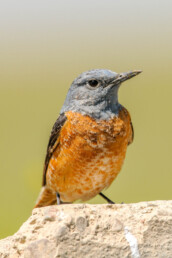
Bird the Kyzyl-Kum desert, a known hotspot for fall migration in Central Asia, crowded with warblers, shrikes, and buntings.
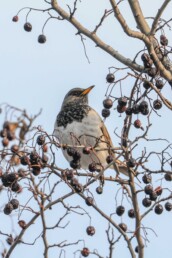
Be lucky, and find the first incoming winter migrants from Siberia, mostly these Black-throated Thrushes are the first to arrive.
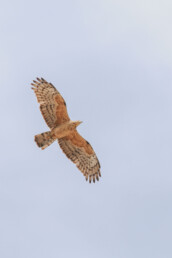
Love three full days of birding the Chokpak ringing station. An excellent spot to be up close with rarities like this Oriental Honey-Buzzard.

Meet your leader
The expedition is led by Machiel Valkenburg, an experienced wildlife leader living for over a decade in Central Asia. He is simply the best leader available for this destination and will provide you with the best experience possible throughout his magical Central Asia.
YOUR
KAZAKHSTAN
ITINERARY
Clients depart from home towards the largest city in Kazakhstan, Almaty. There are several options for arrival, but the best option is by way of Istanbul (Turkish Airlines). Clients need to be in Almaty before 6am on day two! For those who wish to arrive early, please contact the RBT office and we will gladly help you with extra hotel arrangements.
NIGHT | On aircraft
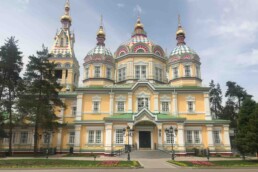
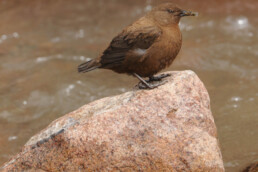
We have a full day scheduled in this glorious high-altitude landscape to find an incredible array of alpine specialists. Black-throated, Altai and Brown Accentors, Sulphur-bellied Warbler, Red-mantled Rosefinch, White-winged Grosbeak, and the incomparable White-browed (Severtzov’s) Tit-warbler await us! We will descend a short distance by coach to the Big Almaty Lake, where extensive, braided, stony riverbeds are home to the utterly unique Ibisbill. We will look for species such as Lammergeier, Himalayan Griffon, Red-billed and Yellow-billed Choughs, Plain Mountain-finches, and White-winged (Güldenstädt’s) Redstart. Most of these species are found high in the mountains at an altitude of 10,500 feet. The star-attraction today, which we have an excellent chance of localizing, is the regal Himalayan Snowcock.
The early evening program includes an enjoyable time in the local park where we will admire the historical Ascension Cathedral (also known as Zenkov’s Cathedral). This monument was built by ancient technology, without a single nail! Such peculiar structure enabled the cathedral to survive the great earthquake that damaged the city in 1910.
NIGHT | Comfortable tourist hotel in Almaty.
Today we travel by air to the west, arriving around noon in Shymkent. This is the third most populous city in Kazakhstan and is located close to the former USSR’s firstly established Nature Reserve. A short drive brings us to the village of Dzhabagly, a little town located in the foothills of the western Tien-Shan Mountains. We will check in to the local guesthouse and get accustomed to our new surroundings. Here the birding starts as this little village is ideally located in the middle of the major migration route. During some tours, we have even had Yellow-breasted Azure Tit and Asian Paradise-flycatcher in the guesthouse garden! We will soon become acquainted with Kazakhstan’s commoner species such as Grey-crowned Goldfinch, White-crowned Penduline Tit, and Azure Tit. Next to the commoner species, we may find such gems here as Eversmann’s Redstart and Blue-capped Redstart in trees along the town’s main street!
The first days of the tour are designed so that we are flexible in deciding which places to visit. The fertile agricultural fields around the village are always suitable for Siberian Stonechat, Pied Wheatear, Red-tailed Shrikes, and large groups of Pine Buntings, the latter wintering in the foothills of the Tien Shan. We may also expect to find the first Black-throated Thrushes that have returned from Siberia. We have a visit to the Ulken Kaindy Gorge planned for when the weather is suitable. Here between the dry, rocky slopes and juniper scrubs, we can find attractive White-capped Buntings, Rufous-naped Tits, Red-mantled Rosefinches, and hopefully more splendid Yellow-breasted Azure Tits! In the Berkara Gorge, we should add Eastern Rock Nuthatch to our list, with Asian Paradise-Flycatcher being a lovely bycatch. Long-legged Buzzards are still numerous at this time of year, and Egyptian Vultures are the most colorful vulture of the day. In the vast reedbeds of Taskol, we shall listen for Clamorous Reed Warblers’ cracking calls, and hopefully, we get our first sightings of White-headed Duck.
Viewing birds of prey in the fall is dependent on the winds. As such, we will decide each morning what options we will explore. The nearby mountain bottleneck is situated, so that northeast winds are best for migrating raptors. The bottleneck funnels raptors across the fields near town, giving us great opportunities to get excellent views of Montagu’s and Pallid Harrier, but also Shikra, Steppe Buzzard, Steppe Eagle, and Crested Honey Buzzard is a possibility.
NIGHT | Comfortable guesthouse, Dzhabagly.
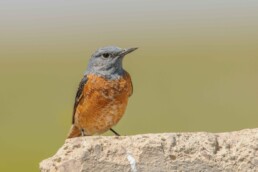
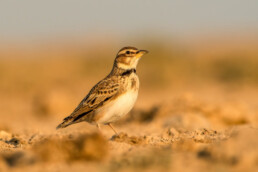
Today we head further west towards the city of Turkestan, birding en route, stopping for anything of interest. Once in the city, we will visit the Mausoleum of Khawaja Ahmed Yasawi, covered with glazed tiles and turquoise ornamentations, typical of the architecture from that period. This particular mausoleum is one of the best-preserved from the Timurid era. This gorgeous structure has come to epitomize the Kazakh national identity. Our journey brings us to the lake system of Shoskakol. During migration times, we can find many unusual species that will use the lakes for a short pause during their travels south. The area is perfect for wildfowl like Garganey, Ferruginous Duck, Red-crested Pochard, and White-headed Duck. Expect also to find Glossy Ibis, Little Bittern, and the wonderful Black-crowned Night-Heron. In the semi-deserts surrounding the region, we will find our first larks, like Calandra and Bimaculated Lark. From here, we will also venture a little further afield towards the Uzbek border in the hope of finding the delightful Streaked Scrub Warbler. We will spend one full day in the sandy deserts with Saxaul vegetation searching for one of Kazakhstan’s most desired species – the superb Turkestan Ground Jay! If we are lucky, we may come across an Asian Desert Warbler, although the majority of this species have departed by this time of year. On all days, we return to Turkestan for the comforts of a delightful hotel.
NIGHT | Comfortable tourist hotel, Turkestan.
Today, another adventure takes us north to the beautiful Lake Kyzylkum. This tiny lake in the middle of an immense desert attracts migrants from all over, a true oasis! The landscape is flat and sandy, covered with small scrubs and wormwood, and at this time of the year, it is teeming with birds. Here we will find loads of shrikes, warblers, larks, pipits, and buntings. We may also find brightly colored Blue-cheeked Bee-eater and will be hoping for a few migrating Booted Warblers and Sykes’s Warblers. Sometimes we are lucky enough to see the sparsely distributed Upchers Warbler and Menetries’s Warbler here. At times, large White-headed Ducks congregate on the lake, with 2000 birds being the largest group ever recorded. This is 20% of the world population of this attractive duck. Tens of thousands of Yellow Wagtails, with many different races, ‘beema’ being the most common one, are common around the lake. Waders are also in their thousands, with Red-necked Phalaropes and Ruffs being the most numerous. We sleep in a basic hotel in one of the nearby villages.
NIGHT | Basic hotel Cholak Korgan.
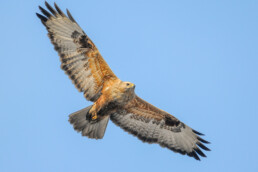
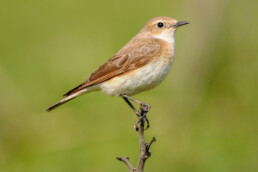
We retrace our steps from the desert to spend our final day in and around Dzhabagly. Here we will visit the same regions as during the first days of the trip. However, because we are a little later in the month, eagles will be dominating the migration streams over the village. We will be on the lookout for beautiful birds like Steppe Eagle, Eastern Imperial Eagle, Greater Spotted Eagle, and the exciting Oriental Honey-buzzard. The numbers of Black-throated Thrushes will have undoubtedly increased by now, a typical winter migrant to Kazakhstan.
NIGHT | Comfortable guesthouse, Dzhabagly.
We do some final birding this morning around the lodge, followed by a short drive back in the afternoon to Shymkent, where we connect with our domestic flight to Almaty. In the evening we will enjoy a lovely final dinner with shaslik and toasts!
NIGHT | Comfortable tourist hotel, Almaty.
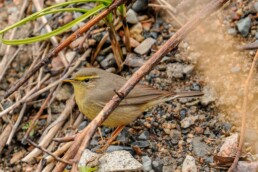
A transfer will be provided very early this morning to Almaty International Airport (airport code ALA), in time for the Turkish Airlines flight to Istanbul, currently scheduled to depart at 3:20 a.m.
- CLICK ON THE IMAGE TO ENLARGE
NEXT TOUR
No scheduled departure
Cost | $2.800 – Domestic flight included
Single supplement | $400
Deposit | $600
Group size | minimum 6 and maximum 10
Best time | September – October
Leader | Machiel Valkenburg
AUTUMN MIGRATION IN KAZAKHSTAN
Kazakhstan, situated at the crossroads of Europe and Asia, is a vital stopover for millions of birds during their autumn migration. Each year, from August to November, a diverse array of species including waterfowl, raptors, and songbirds, travel through the country en route to their wintering grounds.
The vast expanses of grasslands, wetlands, and mountain ranges offer ideal conditions for these migratory birds to rest and refuel before continuing their journey. The migration routes are influenced by weather patterns, food availability, and the topography of the region.
Kazakhstan is an excellent destination for bird enthusiasts and nature lovers alike to witness this incredible natural phenomenon. With over 500 bird species recorded in the country, there is a wealth of opportunities to observe and study the behavior and ecology of these avian travelers.
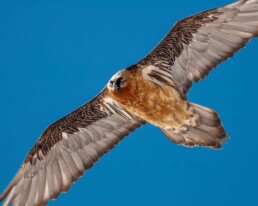
What’s Included?
Expert English-speaking Rubythroat leader
All accommodations
All full-board meals
All land transfers by comfortable coach
Domestic return flight Almaty-Shymkent
Visa support (if needed)
What’s Excluded?
International flight to/from Kazakhstan.
Personal expenses; laundry, telephone costs etc.
Alcoholic drinks.
Extra rooming not mentioned in the itinerary.
Meals on day one.
Single room supplement.
Gracious Demoiselle Crane
Close-up views of Bimaculated Lark
Loads of Rosy Starling throughout!


